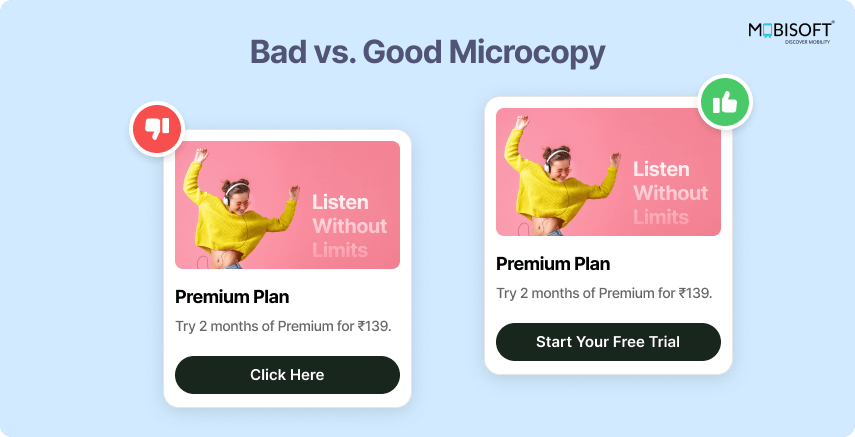Let’s face it, most people don’t read. They scan. So if your product copy feels like a lecture or makes them pause, you’ve already lost them. Good UX writing avoids that. It keeps people moving. It’s the invisible layer that quietly supports every tap, click, and scroll.
UX copywriting is more like being a calm guide, helping people get stuff done. You’re writing for someone who’s halfway through their day, slightly distracted, and just wants to finish whatever task brought them to your app. Strong copy works even better when paired with well-thought-out UI UX copywriting design services that enhance the overall interface.
What is UX Copywriting and Microcopy?

Think of it this way, someone lands on your app or site. They’re trying to complete a task. UX writing and microcopy are what help them do that without friction.
It’s the tiny bits too form labels, hint text, and error messages. These pieces are at the core of UX content design and can make a product feel smooth or frustrating.
If you’re working on a digital product, both web UX design and mobile app UX design play a key role in ensuring these microcopy elements work seamlessly across platforms.
Why is UX Copywriting Important for User Experience?

At its core, UX copywriting exists to improve the user’s experience, and when done right, it can:
Guide user
When done well, UX copy gets out of the way. People shouldn’t wonder what a button does or hesitate to click. The words should quietly nudge them along. This is where UX copywriting best practices matter most.
Increase Engagement
You’d be surprised how often users hesitate just because a button label feels off. Change a “Submit” to something more specific, like “Send Invite,” and suddenly it clicks literally and mentally. These small UX copywriting tips can dramatically improve interaction rates.
Build Trust
No one likes robotic copy. And people pick up on tone fast. If your product sounds stiff or cold, it creates distance. Friendly doesn’t mean unprofessional. It means human. Strong trust-building comes from intentional design choices, as seen in UX strategies for building trust.
Create a Brand Voice
Copy is part of the product’s personality. If the UI looks modern but your language feels outdated or overly formal, users notice the mismatch. Consistent UI/UX copywriting strengthens brand identity.
Enhance Accessibility
Simple language helps everyone, not just those with perfect English or sharp vision. Great product UX writing considers people using screen readers, folks in a rush, or someone just having a bad day.
UX copywriting won’t get awards. But it’s the difference between “I’m done already?” and “Why won’t this work?” It’s small work with a big impact. That’s why it matters.

Key Principles of UX Copywriting
Creating effective UX copywriting starts with a few clear principles that guide clarity and improve user engagement.
Clarity Comes First
Creative flair can help occasionally, but if people don’t understand what you mean within two seconds, the copy has failed. Button labels and tooltips should say what they do a key part of UX writing. No riddles. “Click here” feels lazy. Try saying what happens next. “Start your free trial” or “Download now” just works better.
You want the message to move people forward without making them think twice.
Keep it Short and Sweet
Long lines of copy slow people down. Most folks are in a hurry, especially on mobile. I keep my CTAs, onboarding messages, and even tooltips short and important parts of UI/UX copywriting. One sentence, maybe two. That’s usually enough.
Take this:
“Get Started”
vs
“Click here to learn more about how to get started with our app.”
The first one respects their time. The second one talks too much.
Be Empathetic
When something breaks, copy becomes support. A blank “Something went wrong” makes people feel stuck. Instead, I try to talk like I’m helping a friend troubleshoot. This is where microcopy matters most.
Like:
“Oops! We couldn’t process your payment. Please check your card details or try again.”
That tells them what to do next and feels a bit more thoughtful.
Use Actionable Language
Treat every word like it costs something. No filler. Especially around actions, people need a gentle push, not a shrug. “Submit” feels bland. “Join Now” or “Claim Your Offer” gives direction and adds a little energy. This aligns with UX copywriting tips practiced by experienced specialists.
The idea is simple: show the next step, and make it feel like a good one.
Maintain Consistency
Users get confused when things don’t match. If your call-to-action says “Start Free Trial” on one screen, but “Sign Up” or “Click Here” on another, it slows them down. Keep the language aligned across all touchpoints, a must in any UX content design. Use the same terms, tone, and formatting everywhere. It’s about building familiarity. Once users recognize a pattern, they trust the flow more.
Focus on User
Your users aren’t reading a manual; they just want to get something done. Speak like you would in a conversation. Drop the corporate buzzwords. Skip technical language. Stick to clean, clear phrases that make sense at first glance. This is at the heart of writing for user experience.
Good copy: “Create your account to access our exclusive content.”
Hard to follow copy: “Register for an account to gain privileges for premium content access.”
The first one sounds like a person talking. The second reads like a policy document.
Best Practices in UX Copywriting for Digital Products
Now that you know the key principles, here are some UX copywriting best practices that will elevate your UX copy:
Make It Easy to Scan
People usually scan, they don’t read every word. Break content into chunks. Use headers. Bullet points help too. Nobody likes a wall of text. This is particularly important in UX writing for digital products.
Microcopy Matters
These tiny pieces of error alerts, field hints, and tooltips carry a lot of weight. Write them with care. Make them friendly, clear, and useful. A simple tweak here can save users from dropping off, as shown in many effective UX copywriting examples.
A/B Testing
Gut feeling is fine, but data wins. Try different versions of your copy. See what gets clicks, what reduces confusion. A/B testing is a gold standard for both marketing and UX copywriting services
Optimize for Mobile
Smaller screens leave no room for fluff. Cut extra words. Focus on what’s essential. Make sure your copy still works when space is tight a crucial part of UX writing for mobile apps.
Use Clear Calls to Action (CTA)
If we want someone to take an action, don’t hide it. Use strong, direct calls to action like “Start Free Trial” or “Explore Features.” Be clear. People don’t like guessing.
Following mobile app UX best practices ensures your copy aligns with user expectations and creates a seamless product experience.
UX Copywriting vs. Traditional Copywriting for SaaS and Apps

While traditional copywriting focuses primarily on marketing messages and sales copy, UX copywriting is more focused on user interaction with the product or service. It’s about creating clear, concise, and intuitive content that enhances the user journey. Traditional copywriting might be more persuasive, while UX copywriting for SaaS or apps focuses on usability and user-friendly language.
Traditional Copywriting
The goal is to guide. Traditional copywriting leans into persuasion. UX copy leans into clarity. You’re walking the user through steps, not pitching them.
UX Copywriting
“Don’t miss out, grab the best shoes in town!”
UX Style: “Find your perfect pair. Browse our collection.”
Both have their place. But when you’re inside a product, users want directions, not drama.
Why UX Copywriting Matters in the User Journey
The right words make things feel smooth. When users know what’s next or what just happened, they feel more in control. From signup flows to checkout screens, good UI/UX copywriting takes away friction.
Say you’re wrapping up a payment process. A line like “Your payment is secure,” or “Almost there, just one step left,” brings reassurance. That matters more than we think in UX writing for digital products. Teams often achieve this through a solid UX design system consulting approach, ensuring consistent language and tone across every interaction.
Final Thoughts on Writing for User Experience
UX copywriting is not a box you tick after the design’s done. You’ve got to get into the head of the person using your product, what they’re trying to do, where they might hesitate, and then give them words that help. Keep it plain. Keep it short. Add some warmth. And always point them toward the next step. Do that right, and the whole experience feels smooth. People trust it, and trust makes action easier, clicks, sign-ups, and purchases.
For teams aiming to refine their design process, exploring the right UX prototyping tools and benefits can significantly enhance collaboration and speed up iterations. It could be a big website overhaul, a mobile app launch, or a tiny button label that keeps someone from dropping off. The words should guide, almost quietly, so the user just flows through without thinking about the copy at all.
When you hit that sweet spot, you’re not chasing users; they just keep going because the path feels natural, exactly what great writing for user experience should achieve.





 June 16, 2025
June 16, 2025


